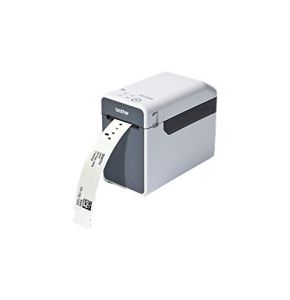Bracelet Printer
18/11/2024 219
Enhance Patient Safety with Our Reliable Wristband Printers
Placemed presents its "wristband printers" stand, specially designed for healthcare professionals. We offer a variety of these important machines, with models suitable for all establishments, big or small, and for all budgets.
Every patient is unique, and it's important to identify them correctly during their care. The wristband printers on this stand help you do just that. They offer excellent print quality, are very fast, and easy to use. These modern machines are indispensable for any healthcare professional who wants to provide quality care.
Whether you are a doctor in a private practice, a nurse in a retirement home, work in a large hospital, or run a clinic, our wristband printers can improve your work. They make your job more efficient and ensure the safety of your patients. With the latest technologies, they print high-quality, durable, and comfortable wristbands for patients, containing all the information you need.
How Do Wristband Printers Improve Patient Safety?
In healthcare settings, precise patient identification is a fundamental step. An identification error can have serious consequences, such as administering the wrong medications, performing procedures on the wrong patient, or mixing up medical records. Wristband printers are essential tools to prevent these errors. They allow you to quickly create personalized wristbands for each patient upon admission.
These wristbands contain crucial information such as the patient's name, date of birth, a unique identification number, and sometimes important medical information like allergies. By scanning the barcode on the wristband, medical staff can instantly access the patient's records. This reduces the risk of errors and ensures that each patient receives appropriate care.
Implementing these identification wristbands contributes to positive patient identification at every stage of their care journey. This strengthens communication between different departments and healthcare professionals, thereby reducing the risks of errors. Patients also feel safer knowing their identity is correctly taken into account.
What Types of Wristband Printers Are Available and What Are Their Features?
There are several types of wristband printers suited to the needs of healthcare facilities. The two main types are thermal printers and laser printers . Each has its advantages and specific features.
Direct thermal printers are very common for their simplicity and reliability. They heat special paper that blackens upon contact with heat, thus creating the print. They are ideal for printing clear and durable barcodes. These printers are compact, fast, and require little maintenance.
Thermal transfer printers use an ink ribbon to transfer ink onto the wristband. They allow printing on different materials and offer better resistance to heat, humidity, and chemicals. They are perfect for wristbands that need to last a long time or withstand harsh conditions.
Laser printers offer high print quality, with sharp text and detailed images. They can print logos, graphics, or photos on the wristbands, which is useful for increased personalization. However, they are generally bulkier and may require more expensive consumables.
Some wristband printer models offer advanced features like wireless connectivity, allowing printing from multiple devices. Others offer additional security options, such as automatic data deletion after printing. The choice of printer depends on the specific needs of the facility and the desired level of personalization.
How to Integrate a Wristband Printer into the Existing Hospital Information System?
Integrating a wristband printer into the hospital information system is essential to ensure smooth operation. Software compatibility is a key factor. The printer must be able to communicate with patient management software to receive the data to be printed on the wristbands.
Network connectivity is also important. Printers can be connected via USB, Ethernet, or Wi-Fi. A network connection allows multiple users to access the printer, which is practical in a hospital where several departments need to print patient wristbands.
For successful integration, it is recommended to work with the facility's IT department. They can ensure the printer is properly configured and secured. Additionally, they can implement protocols to manage sensitive data, guaranteeing patient information confidentiality.
Some manufacturers provide dedicated software or drivers compatible with common hospital information systems. This facilitates the installation and daily use of the printer. By choosing a compatible printer, the facility improves operational efficiency and the quality of patient care.
What Are the Hygiene Considerations for Wristband Printers in Medical Settings?
Hygiene is paramount in healthcare facilities. Wristband printers must be designed to withstand strict cleaning protocols. The materials used should be easy to disinfect without being damaged by chemicals.
The printer's surfaces should be smooth to prevent the accumulation of dust or bacteria. Some models have antimicrobial coatings that prevent germ proliferation. It is essential to regularly clean the printer, especially if it is located in sensitive areas like intensive care units.
Regular maintenance of the printer also contributes to hygiene. By replacing worn parts and cleaning internal components, you avoid malfunctions that could interrupt work. A well-maintained printer ensures quality printing, which is crucial for patient identification.
It is important to train staff on cleaning procedures and maintenance of the wristband printer. Proper use and appropriate maintenance extend the equipment's lifespan and ensure a safe environment for patients and staff.
What Are the Criteria for Choosing the Right Patient Wristband?
Choosing the right patient wristband is as important as selecting the printer. Several criteria must be considered to ensure patient comfort and safety.
Durability is a key factor. The wristband must withstand daily activities without deteriorating. It should endure friction, frequent handling, and remain legible throughout the stay.
Comfort is essential. The wristband should be comfortable to wear and not irritate the skin. Hypoallergenic materials are recommended, especially for sensitive patients. The closure system should be secure without being too tight.
Water resistance is important. Patients may be exposed to water during showers or treatments. A water-resistant wristband ensures that information remains intact under all circumstances.
The printable information on the wristband must be clear and complete. Besides the name and date of birth, the wristband can include essential medical information like allergies. The barcode should be easy for staff to scan.
By considering these criteria, healthcare facilities can choose patient wristbands that meet safety, comfort, and efficiency needs.
 Francais
Francais 
